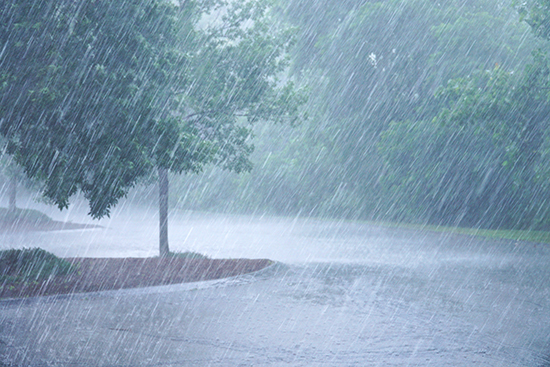
Occupational spring safety hazards: Do you know what they are?
February 22, 2022
By
Gen Handley

Spring can be unpredictable with dangerous weather such as tornados, flooding, and late snowstorms. (nd700/Adobe Stock)
When you think of spring time, what comes to mind? Flowers blooming? Longer, warmer days?
Yes, following the cold winter, the season of rejuvenation is always welcomed with open arms. However, it surprisingly comes with a host of occupational safety hazards unique to that time of year.
Thankfully, with some proactive hazard assessment and planning by employers, these hazards can be mitigated and prevented altogether, making sure that those working outdoors — and indoors — during the spring are protected, happy and productive.
Spring is also seen as a time of rejuvenation and that should include rejuvenating your occupational health and safety program and reassessing what can be done to make a positive impact on the physical and emotional well-being of your team.
Extreme weather
Yes, we mentioned how pleasant spring weather can be, however it can also be incredibly mercurial with more and more extreme and “weirder” weather events affecting everyone, particularly those working outdoors. Springtime across Canada can be unpredictable with dangerous weather such as tornados, flooding, and late snowstorms.
Depending on where you work, the weather and meteorological circumstances of the area will vary and require different occupational protections for employees.
Generally, employers should provide workers with any needed protective clothing and personal protective equipment (PPE) as well as an emergency kit should employees experience an emergency and will need survival supplies such as a warm blanket and food and water.
Prepare for the worst and your team members will be ready for anything.
Increased allergies
According to Asthma Canada and the Canadian Allergy, Asthma and Immunology Foundation, one in four or five Canadians (20 to 25 per cent of the population) experiences allergic rhinitis (a.k.a. “hay fever”) every spring and the intrusive symptoms that come with it.
Hay fever and other springtime allergies from increased dust and pollen affect those working outdoors as well as those inside an office or other building. The reaction to hay fever can range from mild, requiring a box of tissues, to extreme in which the employee’s work is impacted by nasal and eye conditions, difficulty breathing, skin issues, and headaches.
Indoors, regularly cleaning surfaces and a quality ventilation system can reduce allergens amongst employees. Outdoors, employers can provide PPE such as face masks and eyewear to reduce the amount of allergens the worker will inhale.
Additionally, employers should provide coverage for allergy shots and medications as well as any other treatments to make them more comfortable.
Increased heat exposure
The beautiful spring weather can be a double-edged sword in that it also can create dangerous working conditions for people working in- and outdoors.
For a majority of Canadians, March and April is when workers start to feel the workdays heating up, sometimes requiring a change in work clothes and PPE. Dangerous heat stress becomes more prevalent, and employers must take steps to protect their people from rising temperatures.
To combat heat stress, make sure employees drink water every 15 to 20 minutes, make sure employees take regular/frequent breaks in shaded or air-conditioned spaces, acclimatize employees to the hotter work environment with shorter shifts initially, as well as employ an automated check-in system that will confirm their safety after each shift.
Slips, trips and falls
No matter what the season is, slips, trips, and falls are always a major safety concern in the workplace because they are so frequent and can happen almost anywhere. Particularly during the wet spring season, slips and falls are more of hazard because of the increase in slippery surfaces and rails.
If you want to reduce the incidence of slips, trips, and falls, all areas of the workplace must be assessed and identified to determine if it is a safety risk. Once identified, the employer can then look at strategies to mitigate and eliminate the risk through a number of steps including warning signs around high-slip areas, resurfaced walking areas, new footwear for employees,
Insects and wildlife
Across Canada’s 347 million hectares, there is wide range of different natural landscapes that are home to harmful insects and wildlife can be a major safety hazard to be concerned about. Not only can an insect sting or bite be incredibly painful and disruptive, but it could also lead to a fatal allergic reaction. On top of that, with springtime comes certain wildlife (some out of hibernation) who are hungry and more prone to attack a worker who is in their territory or feeding area.
First of all, if any of your team members have a serious allergy to insect stings, you must have any necessary medications (like epinephrine pens) on hand should they get stung. If insects are an issue, provide any necessary protective clothing or PPE to protect workers from a potentially deadly sting. In the case of wildlife, workers can be equipped with certain deterrents such as bear spray as well as an accessible panic button to c all for help in an emergency.
The big picture
Overall, spring is a time when employers should look at the entire picture of their team’s safety and what can be done to improve it during the upcoming year.
It’s a good time to review and refresh safety policies and procedures such general company safety standards, fire drills, near-miss or close-call incident reporting, and health benefits and coverage.
The great news is that employers can do a lot now to increase the safety of their people down the road.
Gen Handley is a marketing and growth co-ordinator with SafetyLine Lone Worker in Vancouver.